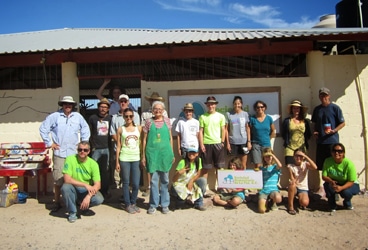
I turned on the headlights and drove slowly out of the colonia on the outskirts of La Paz. It was after 10:00 p.m. and the previous 11 hours had taken their toll physically, but our aches and our hunger and our fatigue were inconsequential measured against the mental and emotional weight of our experience. At that time, it seemed like everything couldn’t possibly have happened the way it did.
The girls sat collapsed in the back seat. Windy sat next to me, sore and completely wiped out. All of us spoke quietly about where we’d stop for a very late dinner on our way back through town. We had to stop for food, we’d hardly eaten all day. Landmarks I noted as we drove out that morning disappeared in the darkness, but I soon found my way back to Highway 1.
Days like this one come at you in life, infrequently and wholly unexpected. But in hindsight, their origins are rarely a mystery. In this case, for this particular day, it can all be traced back to Frances.
You’ll recall I wrote about how her compassion two years ago led us to multiple encounters with an organization called Dogs of La Paz. Well, it’s now called Sociedad Humanitaria de La Paz (SHLP) and since returning to this city on the Sea, Frances has been eager to spend every moment she can at their facility, helping the people help the dogs. Availability of a friend’s car has nearly made that possible.
“Just come with us,” Windy said to me that morning, “they’re having a free spay-neuter clinic and I’m hoping maybe I can get a SHLP shirt for Frances for her birthday–it’s only 20 minutes away.”
Within five minutes of walking up two flights of stairs to the open, top floor of the palm frond-roofed community center, I had a syringe in my hand and was injecting a milky antibiotic into the hind quarter of an anesthetized dog. It was the first time I’d ever stuck a needle in any living thing. I motioned for Windy to take a picture.
The makeshift clinic was in full-swing. A cue of pet owners formed a line in the stairwell, dogs and cats in their arms. At least 40 crates of all sizes were stacked along the walls and there was at least one cat or dog in each. On a patio, a dozen dogs—chihuahuas, pit bulls, spaniels, dachshunds, and muts of every sort—were tied to posts awaiting their turn. Three veterinarians were operating on dogs and cats atop ironing boards draped in plastic and located under the fluorescent lights. On the veranda, 15 dogs and cats were sprawled out on thin yoga mats, receiving post-op care. The incessant sound of dogs barking was a bit maddening and they were short on weekday volunteers: “Que tipo de ayuda necesita?”
At first we all stooped beneath the shade tarp and began learning to take care of the animals in post-op. On our knees, we calmed waking dogs and made sure all canine tongues were visible, hanging slack from parted jaws to ensure an open airway. Cats’ eyes don’t close under anesthesia and Frances diligently applied drops, working the lids to ensure coverage to protect them in the hot, dry air. Eleanor used gauze and hydrogen peroxide to clean the incision areas. Windy oversaw and assisted her two young volunteers.
I was eventually asked to help move the larger animals to and from the operating tables and then spent the rest of my day cleaning pee and poop and vomit from cages and concrete. I learned to shave cats and dogs ahead of surgery, hembras y machos.
Does it sound like hell? I’m not a dog person and definitely not a pee and poop and vomit person; it should have been hell. But it was rewarding and somehow magical.
At the restaurant that night—nearly midnight—my girls talked about all they’d learned and witnessed. Eleanor watched several surgeries from start to finish and related how she was squeamish at the start, but then keenly interested and even learning. Frances told me about how to best manage a waking dog as he stirred and then had questions about the litter that was aborted from one of the last cats to be sterilized.
This MASH-like environment was completely new and foreign to me—it was new and foreign to all of us. Together we were thrust into a challenging, stressful environment. To then watch Eleanor (whose exaggerated disgust at being asked to pick up her sister’s dirty clothes from the floor is worthy of an Academy Award) carefully lift and carry a dozen cats and small dogs from surgery to post-op, responding to only the simple nod of the veterinarian, cradling their limp bodies, never minding the pee and blood, is among the most gratifying experiences I’ve ever had. From across the room, I was unable to help her or even remind her to be careful, to do things this way or that, and I didn’t have to.
Just a day before her 8th birthday, Frances tirelessly attended to the animals in post-op for ten hours straight. Drops in the eyes, soothing words and strokes, wound care, cleaning up pee, turning over and moving animals, calling out numbers taped to collars; she never complained, just made sure that she tended to those in need. Her focus, determination, and desire to nurture are characteristic, but her stamina was noteworthy.
We live in such tight quarters, together almost all the time, I know my girls—yet I was surprised and impressed by them both. As a parent, I can’t ask for much more.
–MR








